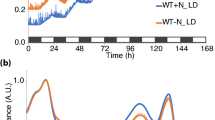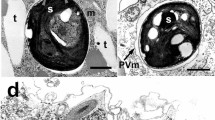Abstract
ALL filamentous blue–green algae capable of fixing elementary nitrogen have heterocysts. Stewart et al.1 have strong evidence that these differentiated cells are the sites of nitrogen fixation. They did not, however, show that photosystem II, responsible for the evolution of molecular oxygen (O2), is not functional in heterocysts. Because high oxygen tension inhibits nitrogen fixation, heterocysts should not possess the pigments of photosystem II. Fay2 produced evidence in vitro suggesting that heterocysts do not contain c-phycocyanin (c-PC), a principal constituent of photosystem II. Stewart et al.1 found much less c-PC in heterocysts than normal cells and believed that photosystem II could be absent in heterocysts. Others3,4, however, have demonstrated the evolution of O2 from blue–green algae in the absence of c-PC. Thus the points to be resolved are whether heterocysts in vivo contain c-PC and the other pigments comprising photosystem II, and whether, in the absence of one or more of these, photosystem II is functional in heterocysts. A comparison of the in vivo pigment composition of normal cells and heterocysts has indicated that heterocysts lack a functional photosystem II.
This is a preview of subscription content, access via your institution
Access options
Subscribe to this journal
Receive 51 print issues and online access
$199.00 per year
only $3.90 per issue
Buy this article
- Purchase on Springer Link
- Instant access to full article PDF
Prices may be subject to local taxes which are calculated during checkout
Similar content being viewed by others
References
Stewart, W. D. P., Haystead, A., and Pearson, H. W., Nature, 224, 226 (1969).
Fay, P., Arch. Mikrobiol., 67, 62 (1969).
Susor, W. A., Duane, W. C., and Krogmann, D. W., in Biochemical Dimensions of Photosynthesis (edit. by Krogmann, D. W., and Powers, W. H.), 36 (Wayne State University Press, Detroit, 1964).
Wolk, S. L., and Bishop, N. I., Photochem. Photobiol., 8, 213 (1968).
Watanabe, A., Proc. Symp. Algol., 162 (Indian Council of Agricultural Research, New Delhi, 1960).
Thomas, J., David, K. A. V., and Gopal-Ayengar, A. R., Proc. First Intern. Symp. on Taxonomy and Biology of Blue–green Algae (Madras, 1970, in the press).
Thomas, J., Phondke, G. P., Tatake, V. G., and Gopal-Ayengar, A. R., Photochem. Photobiol., 11, 85 (1970).
ÓhEocha, C., Ann. Rev. Plant Physiol., 16, 415 (1965).
Craig, I. W., and Carr, N. G., Biochem. J., 106, 361 (1968).
Myers, J., and Kratz, W. A., J. Gen. Physiol., 39, 11 (1955).
Brody, M., and Emerson, R., Amer. J. Bot., 46, 433 (1959).
Hendricks, S. B., in Harvesting the Sun, Photosynthesis in Plant Life (edit. by San Pietro, A., Greer, F. A., and Army, T. J.), 1 (Academic Press, New York, 1967).
Goedheer, J. c., Biochem. Biophys. Acta, 172, 252 (1969).
Author information
Authors and Affiliations
Rights and permissions
About this article
Cite this article
THOMAS, J. Absence of the Pigments of Photosystem II of Photosynthesis in Heterocysts of a Blue–Green Alga. Nature 228, 181–183 (1970). https://doi.org/10.1038/228181b0
Received:
Issue Date:
DOI: https://doi.org/10.1038/228181b0
This article is cited by
-
Energy transfer in Anabaena variabilis filaments adapted to nitrogen-depleted and nitrogen-enriched conditions studied by time-resolved fluorescence
Photosynthesis Research (2017)
-
Membrane targeting of MnSOD is essential for oxidative stress tolerance of nitrogen-fixing cultures of Anabaena sp. strain PCC7120
Plant Molecular Biology (2015)
-
Cell-specific gene expression in Anabaena variabilis grown phototrophically, mixotrophically, and heterotrophically
BMC Genomics (2013)
-
Early candidacy for differentiation into heterocysts in the filamentous cyanobacterium Anabaena sp. PCC 7120
Archives of Microbiology (2010)
-
Unusual radioresistance of nitrogen-fixing cultures of Anabaena strains
Journal of Biosciences (2010)
Comments
By submitting a comment you agree to abide by our Terms and Community Guidelines. If you find something abusive or that does not comply with our terms or guidelines please flag it as inappropriate.



